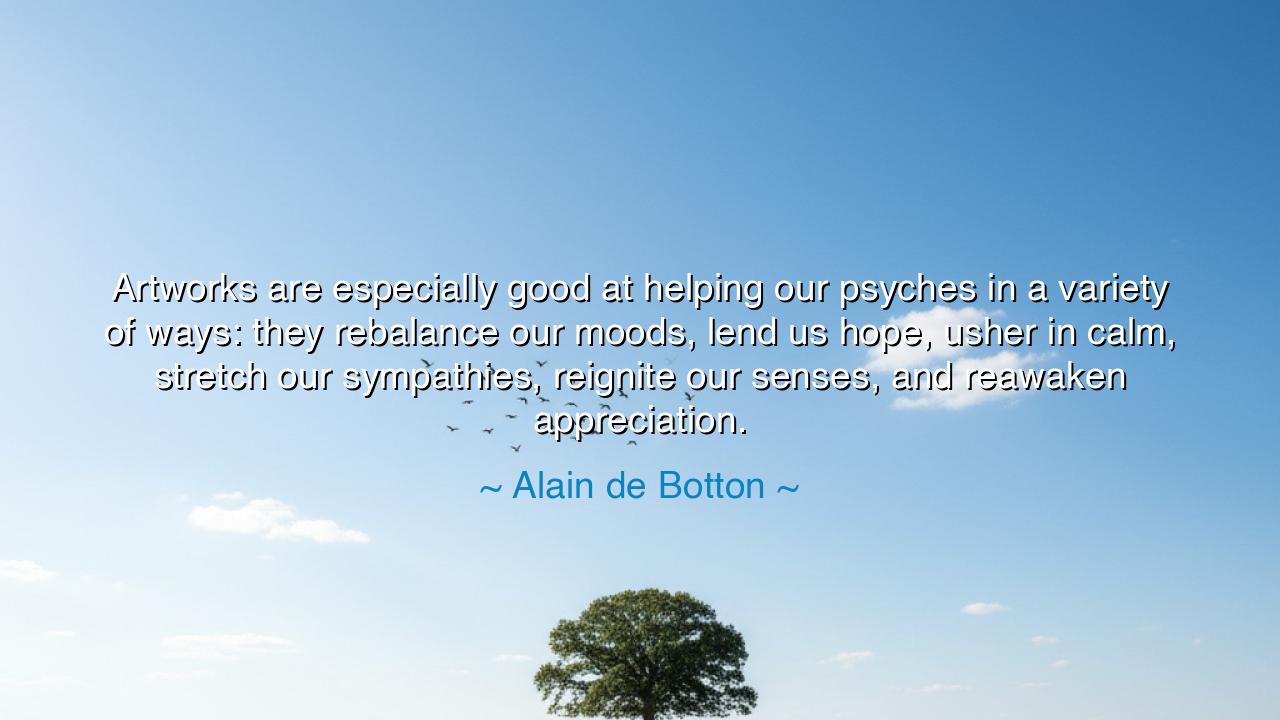
Artworks are especially good at helping our psyches in a variety
Artworks are especially good at helping our psyches in a variety of ways: they rebalance our moods, lend us hope, usher in calm, stretch our sympathies, reignite our senses, and reawaken appreciation.






In the vast tapestry of human existence, where life’s challenges and struggles often weigh heavily on the soul, there exists a powerful refuge in art. Alain de Botton, in his insight, "Artworks are especially good at helping our psyches in a variety of ways: they rebalance our moods, lend us hope, usher in calm, stretch our sympathies, reignite our senses, and reawaken appreciation," speaks to the transformative power of art to heal, uplift, and guide us through the turmoil of life. In the ancient world, art was not merely a form of decoration or entertainment, but a conduit for wisdom, a tool that helped shape the spirit and mind. It is through this lens that we must understand the profound impact of art—not only on the individual but on the collective soul of humanity.
Throughout history, art has always been a source of balance for those who sought to understand their place in the cosmos. The Greek philosophers, such as Plato and Aristotle, recognized that the creation and appreciation of beauty were not mere distractions, but essential to the health of the human psyche. For them, art was a reflection of the ideal—whether through the sculptures of Phidias, the poetry of Homer, or the dramas of Sophocles. These works, though born in a different time, carried with them the timeless capacity to influence the mind, to stir emotions, and to rebalance the spirit. Aristotle, in his exploration of catharsis in tragedy, understood that witnessing the struggles of others through art could purge the audience of their own sorrow, bringing a form of emotional balance and relief.
The ancient Egyptians also knew the power of art to nurture the human soul. Their temples, paintings, and hieroglyphs were not merely decorative, but held deep spiritual significance. Art was a tool for connecting with the divine and for understanding the cycles of life—birth, death, and rebirth. It was through art that they rebalanced their understanding of the world and found comfort in the eternal cycles of the universe. This idea of art as a bridge between the earthly and the divine underscores de Botton’s view that art plays a vital role in reawakening the soul, offering us not just a means of expression but a source of renewed purpose.
In more recent times, we see how art continues to reignite our senses and stretch our sympathies in profound ways. The works of Vincent van Gogh, for example, are not merely about color and form, but about capturing the inner world of emotion and sensation. His Starry Night does not simply depict a peaceful night sky; it communicates a deep yearning and longing, a desire for peace amidst chaos. When we stand before such works, we are not just appreciating beauty; we are participating in a shared emotional experience, one that transcends time and place. This is the power of art—to open our hearts to feelings we may have otherwise neglected, to stretch our sympathies beyond our own narrow perspectives, and to reawaken the deep, often forgotten, appreciation of the world’s beauty.
The ancient Romans understood the role of art in rebalancing the human spirit as well. The magnificent mosaics and frescoes that adorned Roman villas were not just for aesthetic pleasure, but also to inspire feelings of tranquility and serenity. In a world filled with military conquest and political intrigue, the opulence of these artworks provided a counterbalance, offering individuals moments of peace and reflection amidst the chaos of their daily lives. Art had the ability to create a space for the mind to retreat, to breathe, and to find solace in a world often marred by strife. This is still true today, as we turn to art to reignite our senses, to find calm, and to reconnect with the essential truths of existence.
De Botton’s reflection speaks to the deep healing power that art has for the human spirit. Just as ancient civilizations relied on art to connect with the divine and to balance the soul, so too do we find in art today the ability to cope with life’s challenges. Art serves as a reminder of our shared humanity, stretching our empathies and broadening our understanding of the world. It allows us to step outside of our immediate concerns, to see the world through the eyes of others, and to experience catharsis—a release of emotion that cleanses and refreshes the soul.
The lesson here is clear: in times of distress or uncertainty, turn to the healing power of art. Allow it to reawaken your sense of beauty, calm your restless mind, and restore your sense of hope. Whether through the painted canvas, the written word, the musical note, or the sculpted figure, art is a tool for emotional well-being and spiritual nourishment. In our modern world, where the pace of life often overwhelms us, we must remember that the true value of art lies not only in its ability to entertain, but in its capacity to transform, to touch our souls, and to restore the balance we so often lose in the chaos of life. Just as the ancients found solace in art, so too can we, if we embrace its power to heal, connect, and inspire us.






AAdministratorAdministrator
Welcome, honored guests. Please leave a comment, we will respond soon